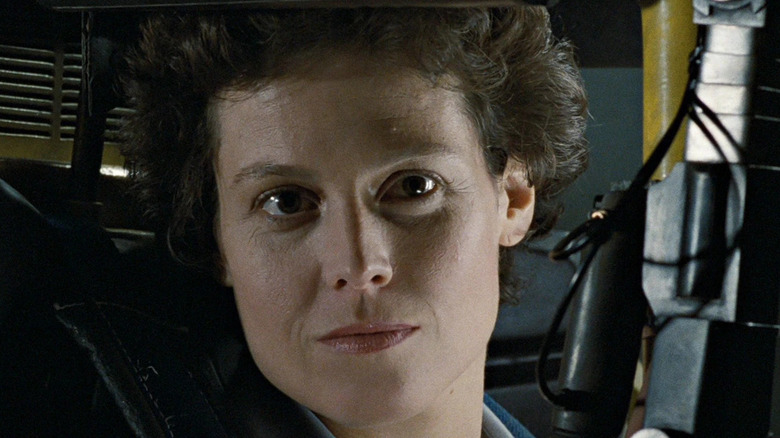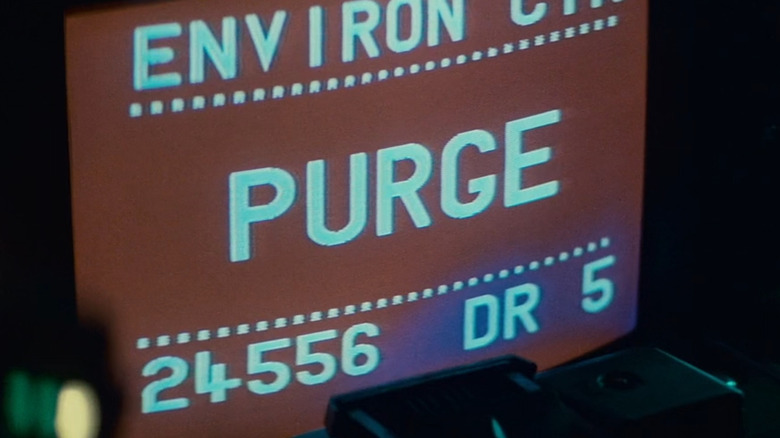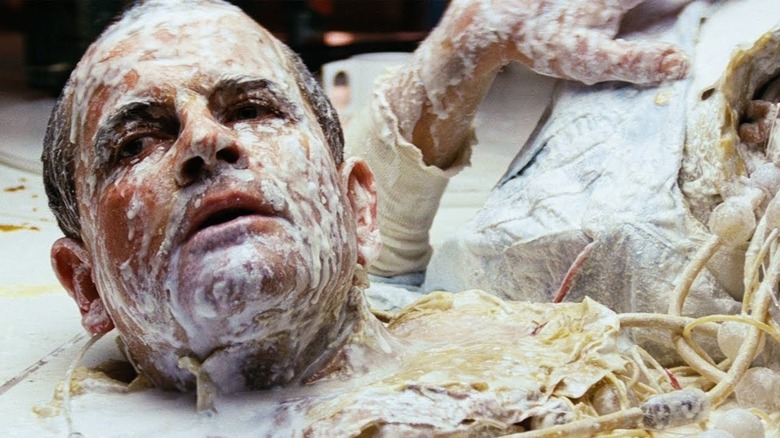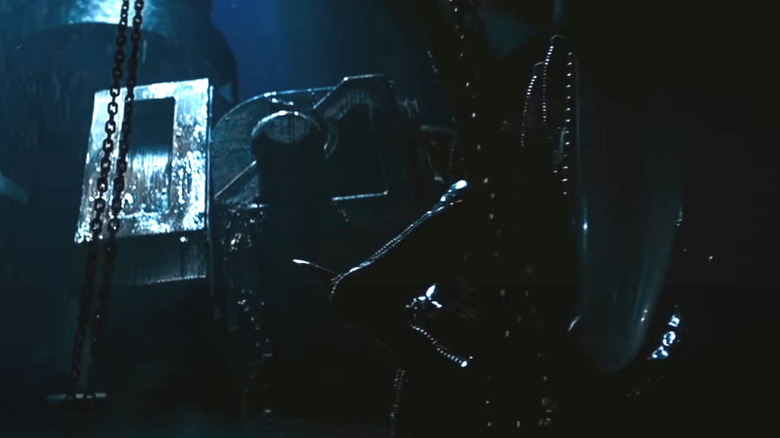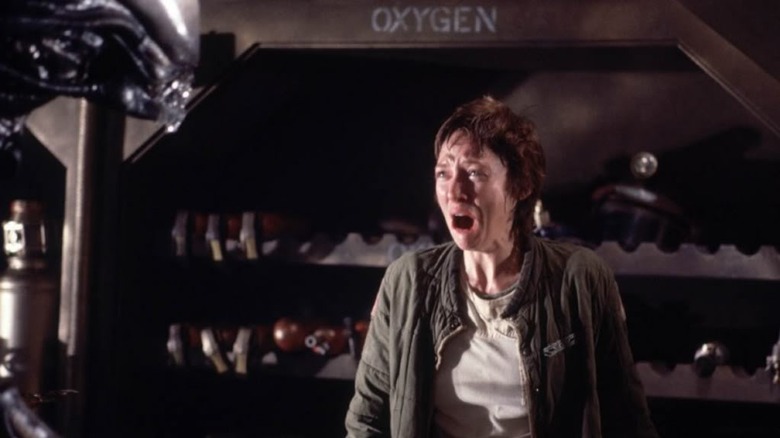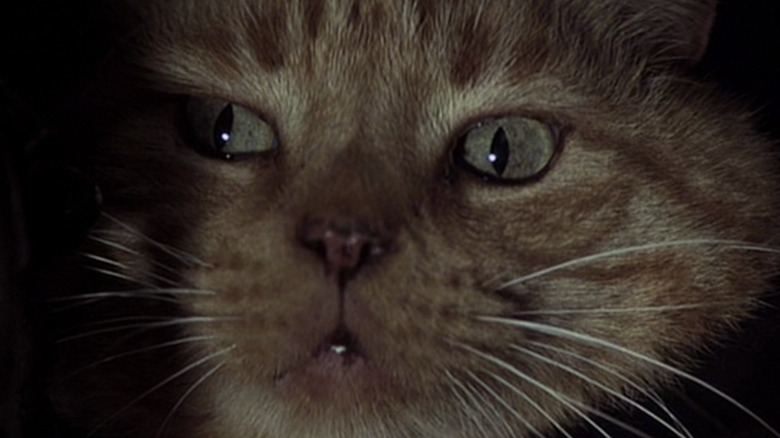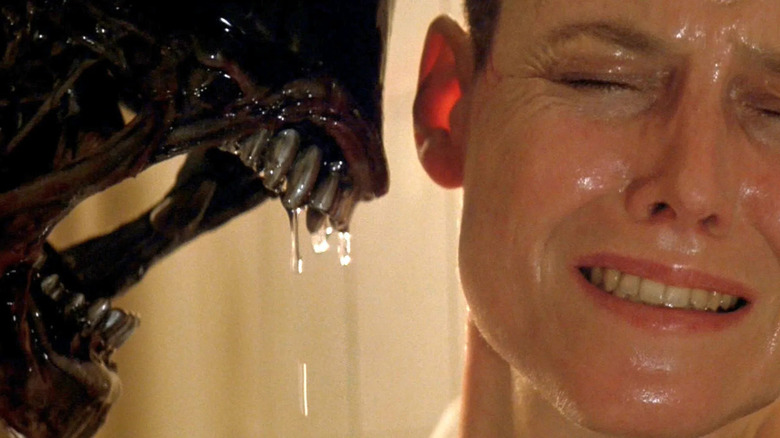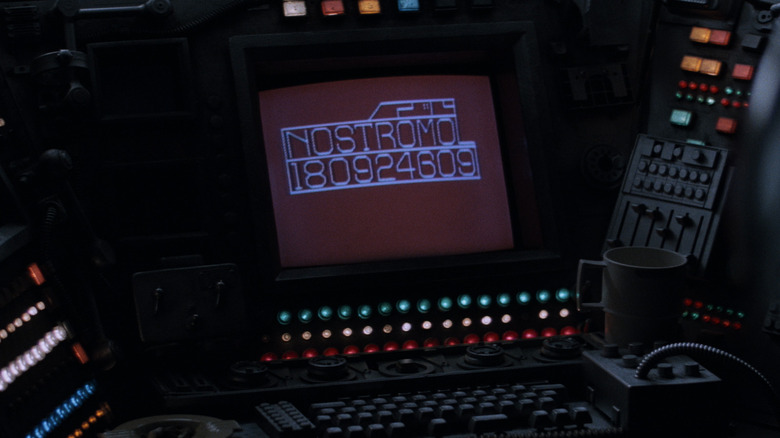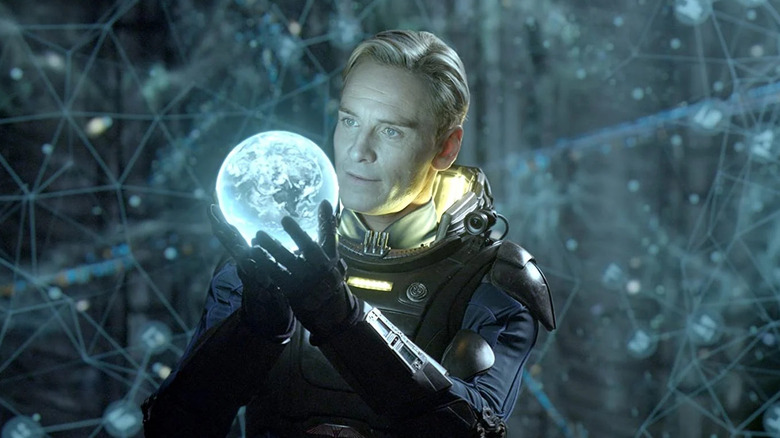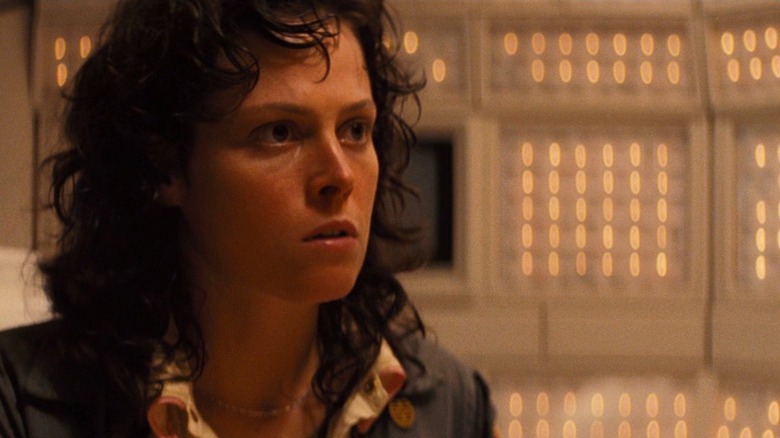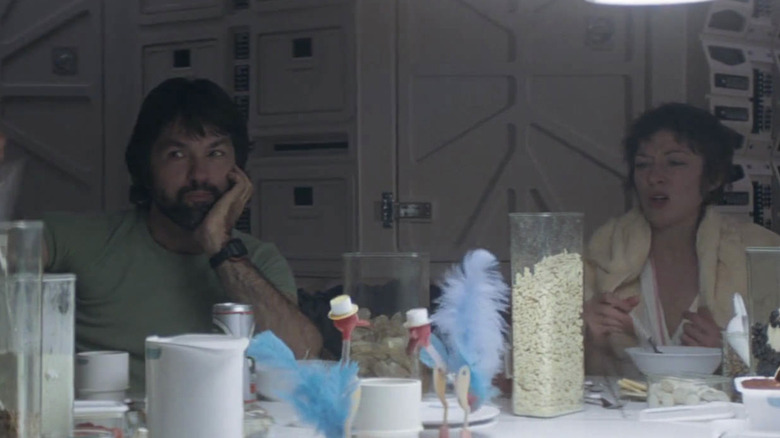Things In The Alien Movie Saga You Only Notice After Watching More Than Once
In 1979, Ridley Scott changed the face of science fiction with the terrifying and spectacular "Alien." This atmospheric, layered horror movie became the cornerstone for a landmark saga of sci-fi movies, video games, and more. Spawning blockbusters like James Cameron's sequel "Aliens" and cult hits like the game "Alien: Isolation," the franchise is a staple in sci-fi horror.
Ridley Scott took up the reins again for the last two movies in the saga, "Prometheus" in 2012 and "Alien: Covenant" in 2017. In 2022, The Hollywood Reporter announced that Scott will produce Fede Álvarez's "Alien" movie for Hulu, which will be the seventh film of the series (not counting the "Alien vs. Predator" digressions as part of the saga).
In anticipation of this upcoming entry to Scott's classic franchise, it feels like a good time to go back and experience the "Alien" saga all over again. Whether you've watched "Alien" and its xenomorph spawn endless times or not, the films all offer up hidden details that make them worth diving back into. Taken as a whole, there are many recurring details and literary allusions in the "Alien" saga that you will only notice after watching the movies more than once and we're here to explain them.
The Alien movies are connected to the Blade Runner universe
It's no secret that there are shared elements that connect the world of Ridley Scott's "Alien" to his other science-fiction masterpiece, "Blade Runner." After all, the filmmaker himself has admitted that he purposefully included shared pieces of world-building between the two movies. In the "Blade Runner" director's commentary, Scott says "this world could easily be the city that supports the crew that go out in 'Alien.'"
This is supported by a computer screen prompt that appears in both films as an easter egg tying them together. At the end of "Alien," when Ripley enters the shuttle to escape the Nostromo, she stumbles past a monitor where a screen reading "Environ CTR Purge" is displayed. This same screen and phrase can be found in "Blade Runner," which came out three years after "Alien" in 1982.
In "Blade Runner," the phrase appears on a computer screen in LAPD officer Gaff's (Edward James Olmos) car when he is transporting Deckard (Harrison Ford) to the police station. It can be seen for just a second, but you can see clearly that the screen says "ENVIRON CTR — PURGE — 24556 DR 5."
In Alien, Ash Never Eats
After watching it a dozen times, it is easy to forget that Ridley Scott's original "Alien" has a major plot twist. Perhaps the first time you watched "Alien," you were totally caught off guard when it was revealed that science officer Ash (Ian Holm) was an android.
Before the launch of the ship, Ash was planted on the Nostromo to observe the crew and ensure they carry out the secret mission. Ash is therefore the only one on board who knew about the creature beforehand and had knowledge of what the Weyland-Yutani corporation's true motives were with the mission.
When watching the film a second (or third or fourth) time, you can pick up on one major clue that gives Ash up from the get go: He never eats. Throughout the more methodically paced first half of "Alien," we get a glimpse into the life of the crew aboard the Nostromo.
We often see them eat meals together and, if you look closely, you'll see that Ash never eats with the rest of the ship's members. Not only does this create a subtle emotional and physical distance between him and the others, but it also hints at his non-human identity since he never has to eat.
In the director's cut, the alien makes a brief early appearance
While many have revisited the original "Alien" repeatedly since its 1979 release, fans got a treat in 2003 when Fox released Ridley Scott's director's cut theatrically (via IGN). The original theatrical release and 2003 director's cut are very similar in length and don't have a huge amount of differences. However, one significant thing the director's cut of "Alien" does change is when the Xenomorph rears its ugly head (and body) for the first time.
After the baby alien escapes from Kane's chest, Brett (Harry Dean Stanton) is searching the ship for the runaway alien specimen. Shortly after, he is killed by the Xenomorph in its first terrifying appearance as a fully grown creature. In the original cut of this film, there is a shot that proceeds this sequence, which pans up to show rafters and the mechanical engineering of the ship.
In Scott's directors cut, this is replaced by a near-identical shot where the Xenomorph can be seen hiding in the dark on the right side of the screen. It's easy to miss, as the creature looks like it's part of the machinery, but even if you do know what you're looking for, the scene isn't any less horrifying.
There is a continuity error in Lambert's death scene
Joan Lambert's (Veronica Cartwright) death in "Alien" is one of the most suspenseful and tragic in the whole "Alien" saga. As she and Parker try to gather resources before escaping the Nostromo, they are ambushed by the sneaking alien. Lambert tries to stay perfectly quiet while hiding from the approaching Xenomorph, and the camera frequently cuts between her and the monster. In this flurry of cuts, however, there is a small continuity error that viewers might notice on their second time around with the 1979 classic.
In the shot of the Xenomorph's tail creeping up between Lambert's legs just before it kills her, you can see that the legs are Brett's (Harry Dean Stanton's). Alien Theory points out that the legs and pants do not match what Cartwright is wearing in Lambert's death scene. Instead, the clip of the Xenomorph's tail curiously prodding the legs was shot previously for Brett's death and then used for this moment instead.
This inconsistency is explained by the fact that Lambert never had a final death scene written. Many alternate versions of the script killed the character off in different ways, but ultimately, none of them were filmed. Instead, Lambert's final fate was left more ambiguous and the extra footage of the alien exploring Brett's legs was woven in to create something more horrific, as sometimes it's even scarier to imagine what happened than to actually see it. So, while Ripley later discovers Lambert's body, we never learn the excruciating details of how Lambert ceased to be.
The many faces of Jonesy the cat
If you claim that Ripley is the only survivor of the Nostromo incident during the first "Alien" movie, you are showing your hand as someone who maybe wasn't paying too much attention while watching the movie. Hardcore "Alien" fans are well aware that the Nostromo's shared pet, Jones (more affectionately known as "Jonesy") the cat, also survives to make an appearance in the 1986 sequel "Aliens." But as you watch and rewatch "Alien" and its sequel, you might be surprised to discover that Jonesy is rarely played by the same cat.
During the production of Ridley Scott's "Alien," Jonesy was played by four cats that looked pretty much identical to one another. Sigourney Weaver told Fandango in 2016 that each cat was used for a different action like hissing or sleeping but thanks to the magic of editing and the fact that all of these cats look so similar, it's a fact that you have to know rather than see for yourself.
Of course, the cat used seven years later to play Jonesy in "Aliens" was a completely different one. The Jonesy that we see in "Aliens" was played by a cat named Boris, as confirmed by its childhood owner on Twitter.
The Xenomorph in the Alien 3 was made without CGI
The iconic H.R. Giger design of the Xenomorph is one of the most important things that the first two movies in the "Alien" saga got right. From the start, the alien design was iconic, meaningful, and made from practical and special effects rather than CGI, which wasn't available at the time.
As Ridley Scott explained to American Cinematographer in 2017, the creation of the alien was a massive undertaking because he wanted it "to look animal-like rather than fantastic — because the word fantastic means 'not quite real,' and I wanted it to look real." His team had the challenge of "actually constructing reality" based on visual concepts.
However, the creation and approach of the Xenomorph is one of many areas where David Fincher's feature film debut of "Alien 3" failed to live up to its predecessors and to date, it remains the lowest-rated of the franchise on Rotten Tomatoes (besides the "Alien vs. Predator" films).
There were a lot of regrettable decisions made during the nightmarish production of "Alien 3," but arguably, the look of the Xenomorph was one of its biggest missteps. In this film, the Xenomorph was made by filming a man in an alien suit, as well as a Xenomorph puppet set against a blue screen (via Bloody Disgusting). The two versions of the alien were then composited together to create what regrettably looks like bad and distracting CGI that has garnered a lot of criticism from fans.
While the sense of terrifying reality in "Alien" and "Aliens" is lost in "Alien 3," repeat viewers can at least rest assured that like the first two films, the third entry also avoids CGI.
The series makes multiple allusions to Joseph Conrad
Those who have watched the original "Alien" multiple times may enjoy keeping an eye out for one of the film's favorite references to fiction: the work of Joseph Conrad, author of "Heart of Darkness." The Nostromo takes its name from Conrad's 1904 novel "Nostromo: A Tale of the Seaboard," which tells the story of an Italian sailor used as a disposable tool for the rich in a fictional South American country. It's a familiar narrative to anyone who knows "Alien" and its class dynamics that play out between the Nostromo crew and the Weylan-Yutani corporation, but the Conrad references don't end there.
At the end of "Alien," Ripley and Jonesy make their escape in a vehicle named Narcissus, which is another reference to one of Conrad's very problematically named novels from the late 19th century.
These literary allusions continued past Ridley Scott's initial involvement with the series. In James Cameron's 1986 sequel "Aliens," there is a transport vessel named Sulaco, which is yet another callback to "Nostromo," as Conrad's novel takes place primarily in the fictional port city of Sulaco. Fincher continued the Conrad tradition by naming the ship in "Alien 3" the Patna, which is the name of the boat in Conrad's 1900 classic "Lord Jim." These subtle homages are hard to catch if you aren't familiar with the author's novels that didn't get adapted into "Apocalypse Now."
The androids' names in the Alien films follow an alphabetical pattern
There are a handful of recurring themes, archetypes, and images throughout the "Alien" movies. One of these is the inclusion of an android character and questions centering around its morality. From Ash to David (Michael Fassbender) in the more recent entries of "Prometheus" and "Alien: Covenant," each of the six main "Alien" movies explores this concept of an android.
Fans of the saga may look for connections between the various androids and can do so by starting with the characters' names, which follow a specific naming convention.
The androids in each "Alien" film are named in alphabetical order. As mentioned, the first android in the first movie is Ian Holm's Ash. In "Aliens" and "Alien 3," Lance Henrickson plays Bishop, an android who subverts expectations by becoming loyal to Ripley. The Joss Whedon-penned "Alien: Resurrection" continued the naming scheme in 1997, with Winona Ryder's android known as Call.
When Ridley Scott returned to the series with 2012's "Prometheus" and 2017's "Alien: Covenant," he also followed the pattern by introducing David. So, we can only expect that when Fede Álvarez's "Alien" entry hits Hulu, it will also feature an android with a name starting with "E."
The Covenant's computer is the same one as aboard Nostromo
While "Alien: Covenant" left fans with a number of unanswered questions, this prequel also establishes some important but easy-to-miss connections to Ridley Scott's original "Alien." First, there's the return of the iconic H.R. Giger designs that "Prometheus" lacks, as we see the origin story of the creature that we first meet in 1979's "Alien" (via Den of Geek). But there's one more concrete and direct connection between "Alien: Covenant" and the original movie.
The computer aboard the Covenant is called MU/TH/UR, which is the same name as the one on board the Nostromo in the original "Alien." While the Nostromo's computer is called the MU/TH/UR 6000, "Alien: Covenant" omits this numerical suffix. The events of the two films suggest that this motherboard on the Nostromo is possibly a later version of that seen in "Alien: Covenant," which makes sense considering "Alien" takes place 80 years after "Alien: Covenant."
The drinking bird is a mainstay easter egg
Despite the way the "Alien" series has bounced between directors and screenwriters, there is one easter egg that has remained in the franchise from the beginning. The drinking bird toys that can be seen in the opening scene of "Alien" have made appearances in most of the series' movies. This perpetual motion toy first shows up in the Nostromo's mess hall when the crew is eating at the start of "Alien."
The drinking bird makes its next appearance in "Aliens" in the opening and fans have also found that the little guy shows up in David Fincher's "Alien 3" as well (via Reddit). While it doesn't seem to make an appearance in "Alien: Resurrection" or "Prometheus," the easter egg returned in 2017 for "Alien: Covenant."
The bird toy shows up as a small detail in "Covenant" and if you are looking for it, you will notice that the camera lingers for just a couple seconds to make the homage clear. One of these drinking birds can also be found as an easter egg in the game "Alien: Isolation" (via Digital Spy). Whether the drinking birds are just a fun detail for fans or have a deeper meaning, we know that we'll be keeping an eye out for them in the next "Alien" installment.
